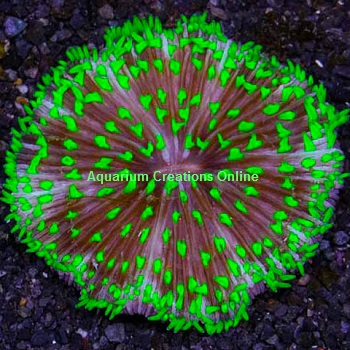The Pinwheel Plate Coral Fungia Sp. is a definite show stopper. Starting with deep purple bands highlighted by icy blue bands, it is the perfect background for neon green polyps. When properly cared for, the Pinwheel Plate Coral is hardy, making it a perfect coral for the seasoned beginner or an awesome addition for the advanced reefer.
Short Tentacle Plate Corals are a large polyp stony (LPS) coral also known as the Fungia Plate Coral, Disc Coral, or Mushroom Coral. They are flat to domed shape, single-polyp corals with one central mouth and a circular shaped body. Color variations include orange, yellows green, red, pink, blue, purple and combinations of colors that are often lined or striped with a bright color. Its genus name, Fungia, was taken directly from the Latin "fungus" (mushroom), which describes its calcareous skeleton shape. It will do best on the bottom of a reef aquarium, preferably lying on a fine sandy substrate. The Short Tentacle Plate Coral is easy to maintain in the reef aquarium and makes an excellent candidate for the beginner reef aquarist.
Difficulty A hardy and easy to care for coral making it a good beginner coral.
Aggressiveness This is a semi aggressive species. They can sting nearby corals so leave a few inches between Short Tentacle Plate corals and other corals in the reef aquarium.
Water-flow
It requires moderate water flow.
Lighting
It requires moderate lighting (PAR 100-150). T5's, Metal Halides, or LED's can all grow Heliofungia plate corals when the proper PAR levels are provided. We recommend a 14-20K color spectrum for best coloration.
Tank Recommendations
For placement keep in mind that it will do best on the bottom of the reef aquarium, preferably lying on a fine sandy substrate. Plate corals often inflate themselves with water and expand to twice their size so enough room must be left for both the expansion and for its sweeper tentacles which can extend beyond its body.
Diet and Feeding
We recommend feeding both a liquid micro-plankton and brine shrimp.
Propagation
In captivity, propagation of short tentacle plate corals can be done by cutting the disc into multiple pie shaped wedges. Use a water saw or other saw that can quickly saw through the bone. Make sure the animal has been well fed and is healthy before attempting this type of fragmentation.
|



